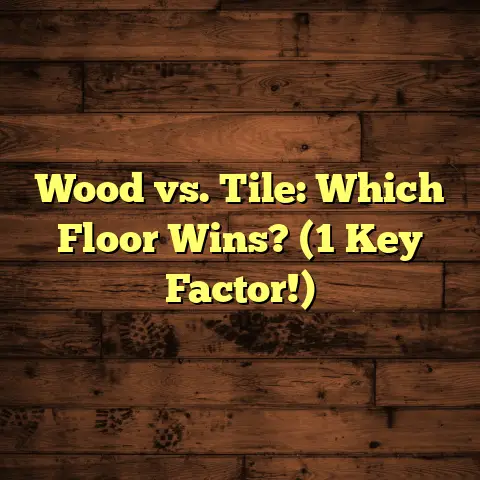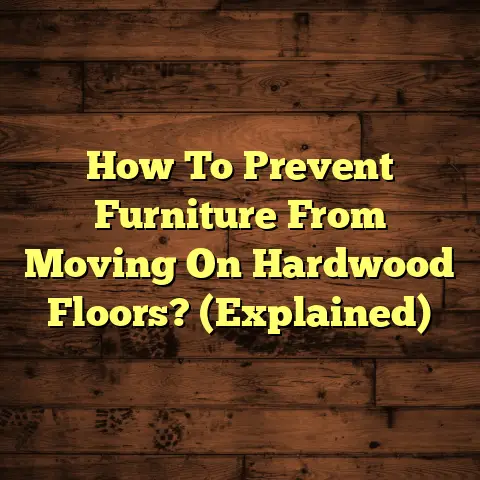How To Stop Furniture Wheels From Damaging Wood Floors?
I’m Mike, a flooring contractor with over 15 years of experience. I’ve seen it all when it comes to wood floors – the good, the bad, and the downright ugly. One of the biggest culprits I see causing damage? You guessed it: furniture wheels.
In our fast-paced lives, we want convenience. We want to roll our office chairs around, glide our serving carts from kitchen to dining room, and rearrange our living room furniture on a whim. But those innocent-looking wheels can wreak havoc on your beautiful wood floors.
Don’t worry, though! I’m here to share my insider knowledge and help you protect your investment. Let’s dive into how to stop those furniture wheels from damaging your wood floors, ensuring your home remains the sanctuary it should be.
Section 1: Understanding the Problem
1.1 The Impact of Furniture Wheels on Wood Floors
Think about it: what kind of furniture is usually equipped with wheels? Office chairs are a big one, especially those ergonomic models we spend hours in. Then there are rolling carts, kitchen islands with wheels, even some sofas and beds are getting in on the wheeled action.
But here’s the deal: those wheels, especially the hard plastic ones, are like tiny little grinders against your floor. Every time you roll, you’re creating friction. This friction leads to scratches, scuffs, and even dents, especially on softer woods.
The mechanics are pretty straightforward: * Pressure: The weight of the furniture and its occupant is concentrated on a small surface area – the wheel. * Friction: As the wheel rolls, it rubs against the floor, creating friction. * Abrasion: Over time, this friction wears away the floor’s finish and even the wood itself.
I’ve seen floors that look like they’ve been attacked by a swarm of angry bees, all thanks to unprotected furniture wheels!
1.2 Different Types of Wood Flooring
Now, not all wood floors are created equal. Let’s quickly touch on the main types:
- Solid Hardwood: This is the real deal – one solid piece of wood from top to bottom. It’s beautiful, durable, and can be refinished multiple times.
- Engineered Wood: This consists of a thin layer of hardwood veneer bonded to a core of plywood or high-density fiberboard. It’s more stable than solid hardwood and less prone to warping.
- Laminate: This isn’t actually wood at all. It’s a synthetic material that mimics the look of wood. It’s affordable and durable, but it can’t be refinished.
The type of finish also plays a HUGE role. A durable polyurethane finish will offer more protection than a softer wax finish.
Think of it like this: a floor with a weak finish is like having bare skin. Anything that rubs against it will cause damage. A strong finish is like having a protective layer of clothing.
According to the National Wood Flooring Association (NWFA), proper finishing can significantly extend the life of your wood floors. National Wood Flooring Association
Section 2: Assessing Your Current Situation
2.1 Evaluating Your Furniture
Okay, time to play detective! Grab a flashlight and start inspecting your furniture. Ask yourself:
- Does it have wheels? Obvious, but start there.
- What are the wheels made of? Hard plastic? Metal? Soft rubber?
- How heavy is the furniture? A lightweight chair is less likely to cause damage than a heavy bookcase.
- How often is it moved? A chair that’s constantly being rolled around is going to do more damage than a cart that stays put.
Don’t underestimate the weight factor. I’ve seen lightweight chairs with hard wheels cause serious damage simply because they’re constantly being used.
2.2 Inspecting Your Wood Floors
Now, let’s move on to the crime scene – your floors! Get down on your hands and knees (yes, really!) and look closely.
- Are there any scratches or scuffs? Pay special attention to areas where furniture is frequently moved.
- Are there any dents or gouges? These are signs of more serious damage.
- Is the finish worn or dull? This means the protective layer is compromised.
If you’re seeing a lot of damage, it’s time to take action. Even if you’re not seeing any damage yet, it’s still a good idea to be proactive.
A simple trick I use is to hold a flashlight at a low angle to the floor. This will highlight any imperfections.
Section 3: Practical Solutions to Protect Wood Floors
Alright, let’s get to the good stuff – the solutions! Here are some practical ways to protect your wood floors from those pesky furniture wheels:
3.1 Choosing the Right Wheels
This is a big one. If you have the option to replace the wheels on your furniture, DO IT!
- Hard Wheels (Plastic, Metal): These are the villains. They’re cheap and durable, but they’re terrible for wood floors.
- Soft Wheels (Rubber, Polyurethane): These are the heroes. They’re gentler on floors and provide better traction.
I always recommend polyurethane wheels. They’re durable, non-marking, and offer excellent protection. You can find them at most hardware stores or online.
A good rule of thumb: If you can scratch the wheel with your fingernail, it’s probably too hard for your wood floor.
3.2 Utilizing Furniture Pads and Protectors
Furniture pads are your secret weapon against scratches. They create a buffer between the furniture and the floor.
- Felt Pads: These are inexpensive and easy to apply. They’re great for chairs, tables, and other lightweight furniture.
- Glides: These are similar to felt pads, but they have a smooth plastic or metal bottom that allows the furniture to slide easily. They’re ideal for heavier furniture that you need to move frequently.
How to Apply Furniture Pads:
- Clean the bottom of the furniture leg.
- Peel off the backing from the pad.
- Press the pad firmly onto the leg.
Make sure the pad is large enough to cover the entire bottom of the leg. I see so many people use tiny little pads that are practically useless!
3.3 Implementing Area Rugs and Mats
Area rugs are not just for decoration; they’re also a great way to protect your floors.
- High-Traffic Areas: Place rugs in areas where furniture is frequently moved, such as under office chairs or in front of sofas.
- Material: Choose rugs made from soft, non-abrasive materials like wool or cotton.
- Rug Pads: Use a rug pad underneath the rug to prevent it from slipping and to provide extra cushioning.
I love using area rugs to define different spaces in a room while also protecting the floors. It’s a win-win!
3.4 Regular Maintenance and Care
Proper maintenance is key to keeping your wood floors in good condition.
- Sweep or Vacuum Regularly: This removes dirt and debris that can scratch the floor.
- Use a Wood Floor Cleaner: Avoid harsh chemicals that can damage the finish.
- Clean Spills Immediately: Liquids can seep into the wood and cause stains or warping.
- Re-Coat the Finish: Over time, the finish will wear down. Re-coating it every few years will help protect the wood.
I recommend using a microfiber mop for cleaning wood floors. It’s gentle and effective at removing dirt and grime.
Section 4: Long-Term Strategies for Prevention
Okay, we’ve covered the immediate solutions. Now, let’s talk about long-term strategies for preventing damage.
4.1 Educating Household Members
This might sound silly, but it’s important! Make sure everyone in your household knows how to treat wood floors gently.
- No Dragging Furniture: Always lift furniture when moving it.
- Be Careful with Heels: High heels can dent wood floors.
- Wipe Up Spills Immediately: Don’t let liquids sit on the floor.
I’ve seen families create a “no shoes” rule in certain areas of the house to protect their floors. It might seem extreme, but it can make a big difference!
4.2 Choosing the Right Furniture for Your Space
When buying new furniture, consider its impact on your floors.
- Look for Furniture with Soft Wheels: As we discussed earlier, soft wheels are much gentler on wood floors.
- Consider the Weight: Heavy furniture is more likely to cause damage.
- Think About Placement: Avoid placing heavy furniture in high-traffic areas.
I always advise clients to think about the long-term implications of their furniture choices. A little planning can save you a lot of headaches (and money) down the road.
4.3 Professional Solutions
Sometimes, despite your best efforts, damage can occur. In these cases, it’s best to consult with a flooring professional.
- Repairs: A professional can repair scratches, dents, and other types of damage.
- Refinishing: If the finish is severely worn, refinishing may be necessary.
- Interior Design Consultation: An interior designer can help you select furniture that complements and protects your wood floors.
Don’t be afraid to call in the experts! A professional can assess the damage and recommend the best course of action.
According to a study by the National Association of Realtors, homes with well-maintained hardwood floors sell for significantly more than homes with damaged or poorly maintained floors. National Association of Realtors
Conclusion
Protecting your wood floors from furniture wheel damage is an ongoing process. It requires a combination of proactive measures, regular maintenance, and a little bit of common sense.
By understanding the problem, assessing your situation, and implementing the solutions I’ve shared, you can keep your wood floors looking beautiful for years to come.
Remember, your wood floors are an investment. Taking care of them will not only enhance the beauty of your home but also increase its value.
So, go forth and protect those floors! And if you ever have any questions, don’t hesitate to reach out to a flooring professional. We’re here to help!





